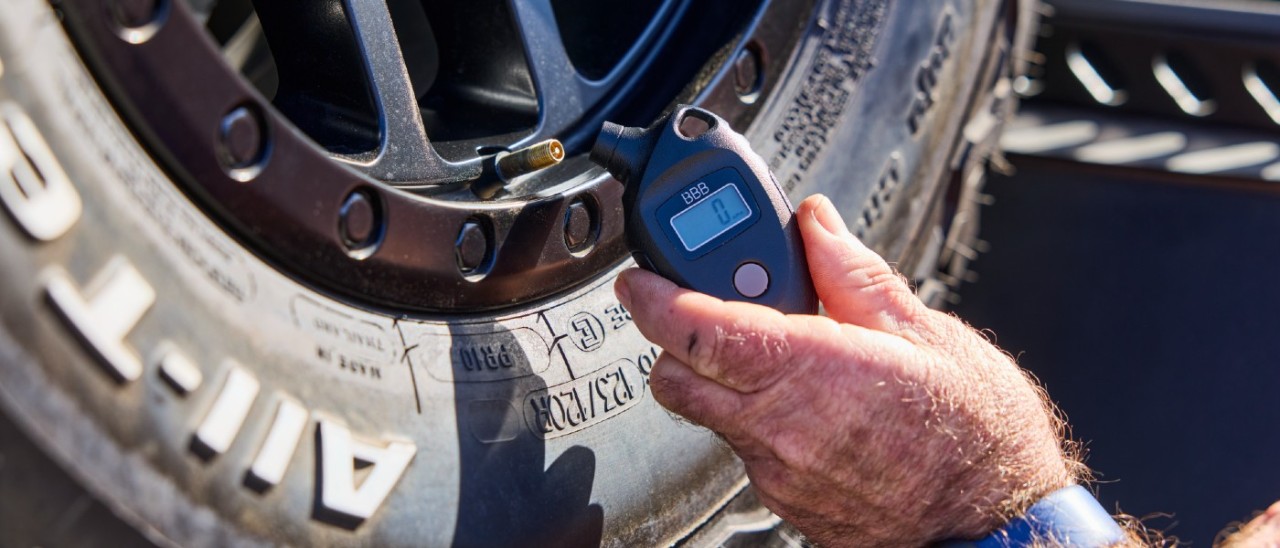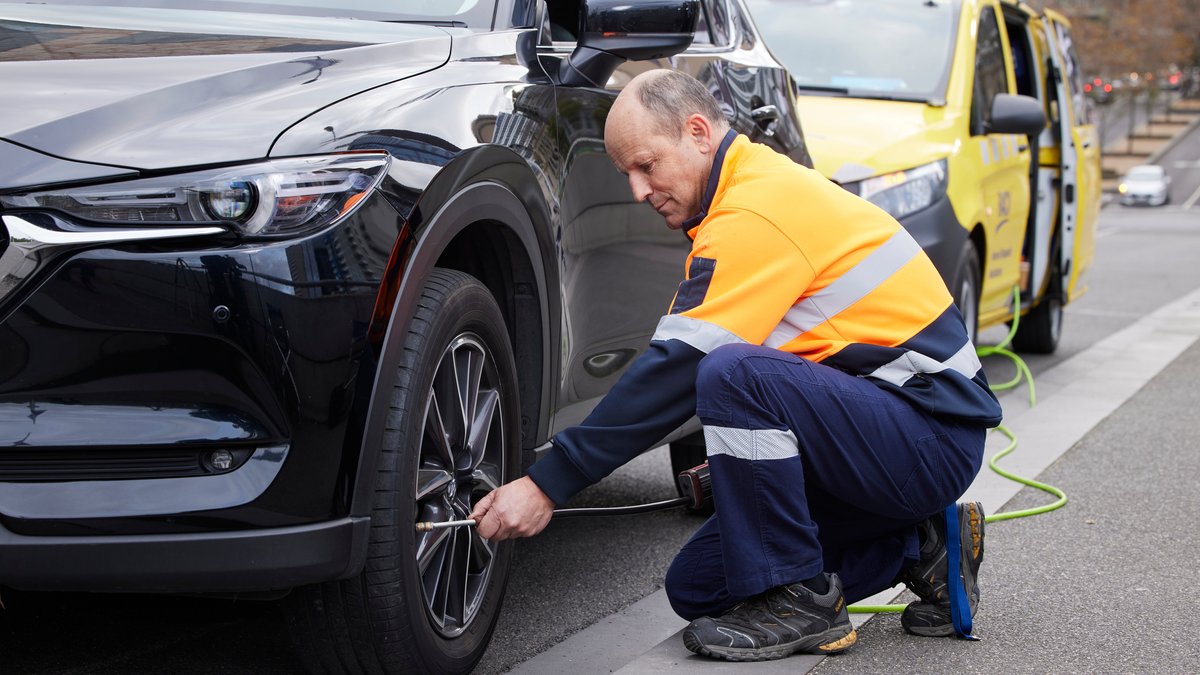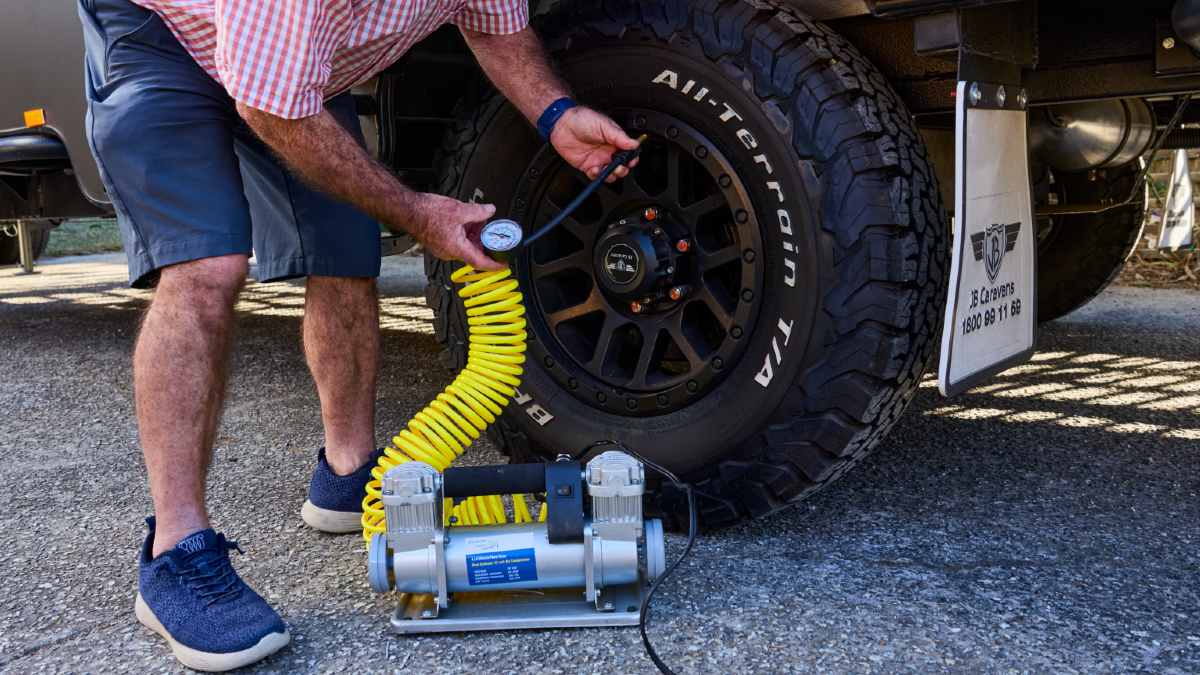Learn why electric vehicles need specialised tyres, how long EV tyres last, and how to choose the right set for safety, efficiency and range.
How to check your tyre pressure and recommended inflation

What PSI should your car tyres be? Understanding your car's tyre pressure and amount of air to put into your tyres is fundamental to driving performance and safety.
Tyres play a key role in your car's handling, stability, and fuel efficiency. Tyre pressure is determined by the amount of air pumped into the tyre and this influences the car's performance. The ideal tyre pressure depends on your vehicle's size and type, with slightly different recommendations for electric vehicles (EVs).
It's important to know how much air to put into your tyres and where you can find this information. Underinflated tyres can lead to reduced traction, longer braking distances, and poor cornering ability. Overinflated tyres, on the other hand, may result in a harsh ride, decreased grip on the road, and uneven tyre wear.
Car tyre pressure and maintainance guide
What PSI should my car tyres be? Where to find out your car's tyre pressure
Your car's manual, a sticker on the driver's side door frame or the door of the fuel filler, will provide the recommended tyre pressure for your vehicle. The ideal pressure might vary based on factors like vehicle load, driving conditions, and tyre type. It might even vary between front tyres and rear tyres. Regular tyre checks are required to maintain optimal tyre pressure.
Tyre pressure is typically measured in pounds per square inch (PSI) or kilopascals (kPa). PSI is widely used in Australia, while kPa is a popular unit internationally. Understanding these units is crucial when you're checking and adjusting your tyre pressure. For example, a recommended pressure of 32 PSI means each tyre should be inflated to 32 pounds of pressure per square inch. Always stick to the recommended pressure for your specific vehicle, and never exceed the maximum pressure indicated on the tyre sidewall.
Recommended tyre pressures for different types of cars
The ideal tyre pressure can vary depending on your vehicle's size and type. Here's a quick rundown of the recommended pressures for different vehicles.
- Small cars like sedans and hatchbacks typically require a tyre pressure between 30 to 35 PSI. This provides adequate road grip and a comfortable drive.
- Medium-sized vehicles such as SUVs and crossovers usually need a slightly higher tyre pressure, typically between 35 to 40 PSI. This supports the additional weight and size of these vehicles, ensuring stability and control.
- Large vehicles like utes, vans, trucks, and 4x4s often require even higher tyre pressures due to their heavier loads and towing capacities. The recommended range for these vehicles can exceed 45 PSI.
While these general recommendations offer a good starting point, your vehicle manufacturer's guidelines determine the ideal tyre pressure. Always refer to your vehicle's manual or the sticker on the driver's side door frame or fuel filler door for accurate information.
Can the weather, towing loads or having extra passengers in your car affect tyre pressure?
Factors such as load and driving conditions can affect the ideal tyre pressure for your vehicle.
Temperature: Hot weather can increase tyre pressure, while colder temperatures can decrease it.
Towing: Towing, whether a caravan or trailer, adds significant weight to your vehicle that can reduce the amount of pressure in your tyres. It is therefore critical for you to adjust your tyre pressure before towing.
Number of passengers: Anything that increases the weight of the vehicle can increase the pressure on the tyres, including having a car full of passengers. A car laden with luggage and passengers should have its tyres regularly checked to maintain optimum PSI.
Regular checks and adjustments based on these factors are crucial for maintaining optimal performance and tyre lifespan.
More: Tyre maintenance, roadworthy and safety checks
Do electric vehicle tyres require higher pressure?
EVs benefit from using specific EV tyres which are tuned for efficiency, comfort and quietness. They may be required to be inflated to a higher pressure than a comparable ICE vehicle. An underinflated tyre can reduce EV driving range and cause irregular tread wear.
EVs can use regular tyres but they must meet or exceed the speed and loading rating for the vehicle (check the tyre placard or ask your fitter for recommendations). Regular tyres may wear more quickly, not deliver the same range efficiency and may be noisier than those design specifically for EVs

It's important to maintain optimum tyre pressure for your vehicle, as both underinflated and overinflated tyres pose risks.
How to check your car's tyre pressure
Here's a simple guide on how to check your vehicle's tyre pressure, how often it should be checked, and the tools you'll need.
Use a reliable tyre pressure gauge to measure each tyre's pressure. Always check the pressure when the tyres are cold, as heat can cause a temporary rise in pressure resulting in an inaccurate reading. Most service stations have a dedicated area for checking and adjusting your tyre pressure. If the measured pressure is lower or higher than the recommended pressure, add or release air until the correct pressure is achieved.
If you're planning on a regional, interstate road trip, or off-road adventure, it's handy to have a tyre inflator in your car, especially if it's a long way to the next service station.
It is recommended that you check your vehicle's tyre pressure at least once a month and before long trips. Regular checks help maintain optimal performance, fuel efficiency, and tyre longevity as tyre pressure can fluctuate due to changes in temperature and normal air loss.
More: Essential items for your car safety and emergency kit
Check the tyre pressure of your spare tyre
Don’t forget to regularly check that your spare tyre is inflated and that it is roadworthy in case of an emergency. Common reasons for flat tyres include: road hazards, poor road conditions, overinflated tyres, sharp objects and extreme temperatures.
Take note of where your car’s locking wheel nut key is located – this is vital if you need to replace a wheel in an emergency. Most new cars have locking wheel nuts, which keep the wheels secure and deter thieves. If your car doesn’t have them, they are available for at automotive stores, but may be vehicle specific.
Emergency roadside assistance offers such services as swapping your flat or damaged tyre with your roadworthy spare. Not all cars come with a spare tyre, in which case you'll need to be towed should you encounter a flat.
Types of spare tyres for cars
Many vehicles come with alternatives to full-size spare tyres, such as space saver and run flat tyres, but there are limits to how they can be used.
- Run flat tyres: These have a reinforced sidewall that will support the weight of your car for a short period if you have a puncture. This gives you the chance to drive to the nearest service station, but you need to drive at a reduced speed to ensure your safety. If your runflat tyre is flat, do not drive the vehicle. Instead, call roadside assistance, as the car may need to be towed.
- Space saver tyre: These are smaller tyres and designed for temporary use. It's important to attach a space saver tyre to the rear of the car rather than front as these tyres can impact your car's performance. This may mean you need to move a rear tyre to the front and then fit the space saver tyre to the rear. If you are using a space saver tyre, drive under the maximum speed limit, and do not drive further than necessary. Be aware that a space saver tyre has less grip and the wheel may spin, making it more difficult to control the car, particularly around corners.
- Tyre inflator kit: These are only suitable for certain types of damage. Read the manufacturer’s guidelines and familiarise yourself with how to use the kit, in case you need it in an emergency.

Call for Emergency Roadside Assistance if you're not confident fitting your spare tyre by yourself.
What is a tyre pressure monitoring system (TPMS)?
A TPMS measures the pressure in your tyres and alerts you (typically by displaying a symbol on your dashboard) when your tyre pressure becomes too low. Unlike in Europe and the United States, Australia does not require most vehicles to be fitted with TPMS. However, several manufacturers (such as BMW and Mercedez-Benz) do include them in certain models. And they are increasingly prevalent in electric vehicles which do not carry a spare wheel, so awareness of tyre pressures is more important.
There are two types of TPMS.
Direct TPMS
A direct TPMS measures the actual pressure within each tyre by using specific pressure sensors. Some systems can also measure the temperature of the tyre. Direct TPMS are more accurate at gauging tyre pressure compared to indirect TPMS.
Indirect TPMS
Indirect TPMS work by using the wheel speed sensors involved in your vehicle’s anti-lock brake system. By measuring the number of wheel rotations your car’s computer can calculate the size of the tyres and determine when a wheel is spinning faster than usual – which can indicate it is underinflated. This TPMS does not measure the actual pressure of the tyre, it simply makes an informed estimation of when it might be underinflated.
Once you have adjusted tyre pressures in a vehicle with TPMS you will either need to reset the pressures on the car’s computer, or drive it for a while to allow the vehicle to measure the pressures itself. If the TPMS warning returns quickly, it could be a sign of a leak or cracked rim so you will need to head to a service centre for an assessment.

Carrying a tyre pressure gauge and an air compressor are helpful for maintaining tyre pressure if you don't have relaiable access to a service station. Image: Matt Harvey
Essential tools for car tyre pressure maintenance
If you do not want to go to a service station to check your tyres, there are tools you can add to your car emergency kit. To maintain your vehicle's tyre pressure, you'll need a reliable tyre pressure gauge, an air compressor or access to an air pump, and optionally, a valve cap tool. These tools allow you to measure and adjust your tyre pressure accurately, ensuring your vehicle remains safe and efficient.
More: How to buy the best tyres for your car
Understanding the role of tyre pressure in vehicle safety and fuel efficiency
Tyre pressure plays a significant role in both the safety and efficiency of your vehicle. It affects fuel consumption, tyre wear, and overall performance.
Proper tyre pressure greatly influences fuel efficiency. Under-inflated tyres create more rolling resistance, making the engine work harder and consume more fuel. For every 1 PSI drop in tyre pressure, fuel efficiency can decrease by up to 0.3 per cent, leading to higher fuel costs over time.
Tyre pressure also directly impacts tyre wear. Insufficient pressure causes the tyre's outer edges to wear faster, while over-inflation causes faster wear in the centre. Both scenarios lead to uneven tread wear, reducing your tyres' lifespan and potentially affecting their performance.
Correct tyre pressure is also critical for vehicle safety. Under-inflated tyres can affect handling and braking, increase stopping distances, and decrease vehicle control. They can also increase the risk of a blowout, especially at high speeds. Over-inflated tyres, on the other hand, have reduced road contact, affecting traction and stability, particularly in wet or slippery conditions.


